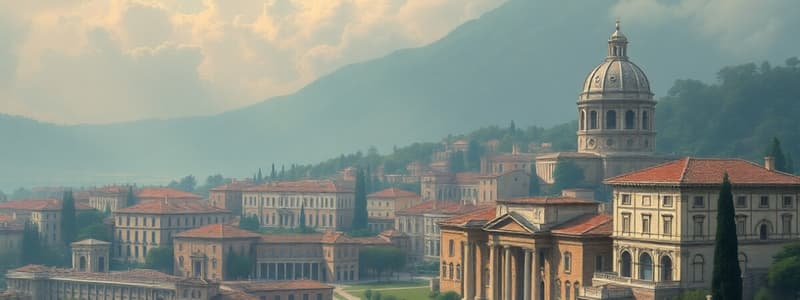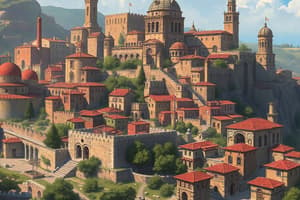Podcast
Questions and Answers
What was Ostia Antica primarily known for during its peak?
What was Ostia Antica primarily known for during its peak?
- Serving as Rome's main port (correct)
- Housing emperors and their families
- Being a military stronghold
- Being a cultural center for arts
How many people lived in Ostia Antica at its height around the second century A.D.?
How many people lived in Ostia Antica at its height around the second century A.D.?
- 100,000
- 30,000
- 50,000
- 80,000 (correct)
What contributed to the preservation of Ostia Antica as a historical site?
What contributed to the preservation of Ostia Antica as a historical site?
- Tidal mud and blowing dirt (correct)
- A volcanic eruption
- Mining activities
- Natural flooding
What innovative feature did Ostia Antica have that showcased its advanced plumbing system?
What innovative feature did Ostia Antica have that showcased its advanced plumbing system?
What factor led to the decline of Ostia Antica?
What factor led to the decline of Ostia Antica?
What is unique about Pompeii compared to Ostia Antica?
What is unique about Pompeii compared to Ostia Antica?
What was one of the main functions of the public bathhouses in Ostia Antica?
What was one of the main functions of the public bathhouses in Ostia Antica?
When did major excavations of Ostia Antica begin?
When did major excavations of Ostia Antica begin?
What major archaeological project is ongoing in Pompeii?
What major archaeological project is ongoing in Pompeii?
In what way is Ostia Antica often described compared to Pompeii?
In what way is Ostia Antica often described compared to Pompeii?
What essential role did Ostia Antica serve in relation to ancient Rome?
What essential role did Ostia Antica serve in relation to ancient Rome?
How did the natural elements contribute to the preservation of Ostia Antica?
How did the natural elements contribute to the preservation of Ostia Antica?
Which infrastructure element exemplifies Ostia Antica's advanced plumbing system?
Which infrastructure element exemplifies Ostia Antica's advanced plumbing system?
What significantly contributed to the decline of Ostia Antica?
What significantly contributed to the decline of Ostia Antica?
How does Ostia Antica differ from Pompeii in terms of preservation?
How does Ostia Antica differ from Pompeii in terms of preservation?
Which statement is accurate regarding the societal significance of Ostia Antica?
Which statement is accurate regarding the societal significance of Ostia Antica?
Why did Pompeii become more well-known than Ostia Antica for archaeological studies?
Why did Pompeii become more well-known than Ostia Antica for archaeological studies?
What aspect of public baths in Ostia Antica highlights its advanced features?
What aspect of public baths in Ostia Antica highlights its advanced features?
What can likely be concluded by future anthropologists regarding human civilization if they only study cities like Ostia Antica?
What can likely be concluded by future anthropologists regarding human civilization if they only study cities like Ostia Antica?
What was a major factor in the decline of Ostia Antica as a significant urban center?
What was a major factor in the decline of Ostia Antica as a significant urban center?
Which characteristic uniquely differentiates Ostia Antica from other ancient Roman cities?
Which characteristic uniquely differentiates Ostia Antica from other ancient Roman cities?
What structural feature of Ostia Antica indicates advanced engineering for its time?
What structural feature of Ostia Antica indicates advanced engineering for its time?
What was the primary role of public baths in Ostia Antica?
What was the primary role of public baths in Ostia Antica?
What led to the preservation of Ostia Antica over the centuries?
What led to the preservation of Ostia Antica over the centuries?
How did the size and structure of Ostia Antica compare to Pompeii?
How did the size and structure of Ostia Antica compare to Pompeii?
Which statement accurately describes the nature of the city of Ostia Antica at its peak?
Which statement accurately describes the nature of the city of Ostia Antica at its peak?
In terms of anthropological studies, what might future researchers find interesting about Ostia Antica?
In terms of anthropological studies, what might future researchers find interesting about Ostia Antica?
What aspect of the restoration efforts in Pompeii contrasts with the history of Ostia Antica?
What aspect of the restoration efforts in Pompeii contrasts with the history of Ostia Antica?
Flashcards are hidden until you start studying
Study Notes
Ostia Antica: A Roman Port City
- Ostia Antica, located near the mouth of the Tiber River, served as the port of ancient Rome.
- Its location made it crucial for receiving goods from across the Roman Empire.
- During its peak (around the 2nd century AD), over 80,000 people inhabited the city.
- The city featured advanced plumbing systems, including public baths and running water in communal restrooms.
- Lead pipes and steam-powered heating systems demonstrate the city's technological sophistication.
- Ostia Antica's decline mirrored that of the Roman Empire, leading to its eventual abandonment.
- Over time, sediment and sand covered much of the city, aiding its preservation.
- The Tiber River's shift and silting of the port contributed to the city's obscurity.
- Major excavations began in the early 1900s, bringing Ostia Antica to light.
Pompeii: A City Preserved by Volcanic Ash
- Pompeii, a city buried by the eruption of Mount Vesuvius in 79 AD, provides insight into Roman daily life.
- A 20-year restoration project focused on a former slave's house offers a look at Roman society.
- Ongoing archeological work continues to uncover and preserve Pompeii's history.
Comparison of Ostia Antica and Pompeii
- Both cities offer glimpses into ancient Roman life, but through different lenses.
- Pompeii shows life in a wealthy city suddenly frozen in time by a volcanic eruption.
- Ostia Antica presents a more comprehensive picture of ordinary life in a working port city.
- Both sites offer unique perspectives for understanding Roman civilization.
Ostia Antica: A Glimpse into Roman Daily Life
- Ostia Antica, located near the mouth of the Tiber River, served as the port of ancient Rome.
- Unlike Pompeii, Ostia Antica provides insights into the daily lives of ordinary Romans, not just the wealthy elite.
- Its population peaked around the 2nd century A.D., reaching over 80,000 inhabitants.
- The city's infrastructure included advanced plumbing systems, featuring running water in public restrooms and large public baths with hot, cold, and warm pools.
- Lead pipes, still visible in some areas, transported water throughout the city. Some buildings utilized steam heating systems generated by giant boilers.
- Ostia Antica's decline coincided with the Roman Empire's fall, ultimately leading to its abandonment.
- Over time, the city was buried under layers of mud and sand, contributing to its preservation. A shift in the Tiber River's course also silted up the port.
- The site remained largely unknown until major excavations commenced in the early 1900s.
Pompeii: Restoration and Insights into Roman Society
- A 20-year restoration project in Pompeii focused on a home previously owned by former slaves.
- This restoration offers a unique perspective on Roman social life before the city's destruction by the eruption of Mount Vesuvius in 79 A.D.
- Pompeii's archaeological excavation and restoration continue to this day.
Ostia Antica: A Glimpse into Daily Roman Life
- Ostia Antica, located near Rome, offers a unique perspective on everyday Roman life, unlike the more opulent ruins of Pompeii or Rome itself.
- Served as Rome's port, handling goods from across the Roman Empire. The Tiber River's shallows prevented large ships from reaching Rome directly.
- Boasted a population of over 80,000 during its peak in the 2nd century AD.
- Featured advanced plumbing systems including public baths with hot, cold, and warm pools, and extensive water pipes (some still visible). Steam heating was used in certain buildings.
- Declined with the Roman Empire and was eventually abandoned, becoming mostly obscured by mud and sand over centuries. The Tiber River's course changed, silting up the port.
- Remained largely forgotten until significant excavations began in the early 20th century.
Pompeii: Restoration and Insights into Roman Society
- A 20-year restoration project in Pompeii revealed details of a house owned by former slaves.
- This restoration provides insights into Roman social life before the city's destruction by Mount Vesuvius in 79 AD.
- Pompeii's ongoing excavations and restoration continue to reveal valuable information about Roman civilization.
Studying That Suits You
Use AI to generate personalized quizzes and flashcards to suit your learning preferences.




